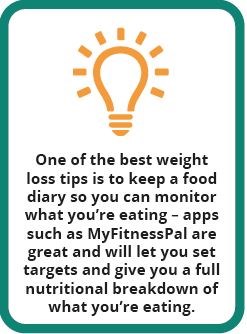Low calorie/low fat
Before you make any changes to your diet please speak to your healthcare team particularly if you are taking medication for your diabetes.
This is a traditional approach to weight loss as it is based on the Eatwell guide with a focus on reducing fat intake. Fat contains more calories than any other nutrient so by reducing your fat intake, you will reduce your calorie intake too. As a guide, active men need around 2,500 kcal a day to maintain a healthy body weight and active women need around 2,000 kcal a day.

To lose 1 - 2lbs (0.5 to 1kg) per week you need to reduce your calorie intake by around 500 - 600kcal per day.
Reducing your intake of fat can also help lower your cholesterol levels, which if increased, can be a risk factor for developing heart disease.
The role of fat in our diet
A small amount of fat is essential as it provides us with energy and helps with the absorption of vitamins A, D, E and K. Fat contains essential fatty acids such as omega 3 which are important for heart and brain health. Excess fat that is not used by your body is converted into fat stores.
What does a low-fat diet involve?
A low-fat diet will typically include foods such as:

- Wholegrain foods: These come under starchy carbohydrates and will provide slow-releasing glucose into the bloodstream. They are also an important source of fibre, vitamins and minerals. Examples of these are oats, wholegrain bread, pasta and rice.
- Lean meats: A source of protein that is essential for the growth and repair of muscles and tissues. Choose meats such as skinless chicken and turkey.
- Fish: White fish such as haddock or cod are lean sources of protein and oily fish such as salmon, sardines, tuna and mackerel are full of omega-3 fatty acids which are important for brain and heart health.
- Dairy: A rich source of calcium which is important for bone health. You should choose low-fat varieties such as skimmed milk, low-fat yoghurt and cheese
- Fruit & vegetables: Provide us with an important source of vitamins, minerals and fibre.
- Lentils, beans and pulses: Low in fat and an important source of protein, fibre, vitamins and minerals.
What foods should I avoid?
If you want to follow a low-fat diet, then you should avoid foods such as:


- Animal fats: Foods that contain animal fats such as butter, cheese, cream, dripping and lard should be avoided on a low-fat diet as they are high in saturated fat.
- Red & Processed meat: Processed meats such as bacon and sausages contain a lot of saturated fat. Stick to lean meats and cut any visible fats off meat.
- Processed foods: Processed foods are defined as any food that has been altered in some way during preparation. These include cakes, pastries, biscuits, fast food, pies, crisps and convenience foods. They are generally high in calories due to the amount of saturated fat and added sugar.
- Deep-fried foods: Foods that have been deep-fried such as fish and chips, chicken strips or tempura are very high in calories and saturated fat as when foods are fried, they lose water and absorb the fat instead.
Food labelling
It’s important to understand what’s in the food you eat so that you can control your intake of calories, fat and saturated fat. Nutrition labels on food can often be difficult to understand, however, interpreting these labels properly can help to make healthier food choices simpler and easier.

Nutritional information can be found on the back or side of the packaging, and more increasingly in the form of a traffic light system on the front of the packaging. This labelling contains information about the amount of energy the food contains (measured in kJ or kcal), as well as the fat and saturated fat content. This information can either be displayed as per pack, serving or per 100 grams of the food.
What do the numbers mean?
The numbers on the packaging let us know if the food we are looking at is high in calories, fat and saturated fat or low or somewhere in between. Have a look below for some reference ranges to help you understand food labels in future:



To help with food shopping, Public Health England has developed the Change4Life Food Scanner app that is free to download on both the App Store and Google Play. The app allows you to scan barcodes of packaged food and drinks to tell you how much sugar, saturated fat, salt and calories are in foods to help you make better food choices.
Tips to reduce your fat intake
We’ve included some tips below on how you can reduce your fat intake when cooking at home or when you eat out:
At home:
- Grill, bake or steam food rather than frying or roasting
- Measure oil with a teaspoon to control the amount you use
- Trim any visible fat from meat and take the skin off poultry before cooking
- Reduce your meat intake by increasing the number of vegetables or add beans or pulses to bulk out dishes
- Use reduced-fat spreads based on olive or sunflower oils instead of butter
- Instead of beef mince, use turkey or Quorn mince
Eating out:
- Ask for any dressings or sauces on the side so you can control how much you eat
- Avoid anything described as ‘fried, sauteed, roasted or crispy’ as it usually means they have been fried in oil
- Choose tomato-based sauces over creamy or cheesy sauces
Tracking your Progress
Registering for MyWay Diabetes will allow you to track your progress on your weight loss journey, you will be able to see your weight, BMI and waist measurement, HbA1c and cholesterol readings click here to register.








